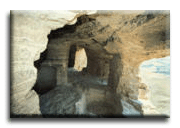|
||||||||||||
|
|
Sites in the Tahirler Survey Region
Kilisiler Caves
Members of the Tahirler Project staff first visited the Byzantine
cave complex at Kilisiler in 1996. The site is well-known among local
farmers, since the cave complex is clearly visible in the cliffs high above
the modern road leading from Beypazari to the villages of Tahirler and
Tacettin. There is also a direct line of vision up to the cave complex
from the “North Churches Area,” where in 1997 we identified and mapped the
remains of a pair of early Byzantine churches (ca. sixth-century C.E.).
Though clearly visible from below, the caves are difficult to access,
and it was not until this past season, in 2001, that we had the time
and expertise to fully document the complex. The attached
map provides an architectural
diagram of the cave complex which extends over three levels
(connected by two spiral stairwells) and includes sixteen rooms of
varying shapes and sizes. The main hall of the complex, oriented N-S,
is over 23 meters long and 4 meters wide, with a series of three storage
pits on its southern end (where there is more natural light and less
dampness). There are further sunken, large rectangular rooms at the
north end of the main hall, with a short, dead-end hallway (once sealed)
at the northeast corner of the hall.
Adjacent to the first set of pits and adjoining the main hall there is a doorway with a raised niche on its left side and the indentation of a Maltese cross above its lintel. The interior of the niche preserves fragments of ancient plaster, on which there are traces of paint; the plaster is, however, covered with modern graffiti. This door leads into a rectangular room (4.2 by 3.5 meters), oriented to the east, with a slightly raised and roughly apsidal area on its eastern end. We have tentatively identified this room as the “chapel room.” The chapel room has a light well on its southern side, and there is the indentation of a second larger cross on the interior of the sill where the light well meets the chapel room. There are a further series of indentations on the north wall and floor of the room that may indicate the placement of a wooden dividing wall (or iconostasis?), marked on the diagram with a dotted line. Although there is limited evidence to determine the exact use and occupational history of these caves, the basic architectural layout of the complex, combined with its surviving Christian decoration, strongly suggests that the Kilisiler cave complex should be associated with the Byzantine period. Can we be more precise? Few sherds were found within the cave, and of these sherds only one can be dated as possibly early Byzantine. Careful survey of the steep and badly eroded slope immediately beneath the mouth of the caves, however, produced a more substantial concentration of ceramics. The ceramics collected from this small area included several fine ware indicators with green and brown glazes that can be firmly dated to the Middle Byzantine period. Further study of these ceramics during the proposed 2002 study season in the Ankara museum will allow us to confirm this dating. Several pieces found in this area also appear to date to much earlier phases of Byzantine occupation and may provide a direct link to the early Byzantine ceramics from the “North Churches” area at Kilisiler. |
|||||||||||




